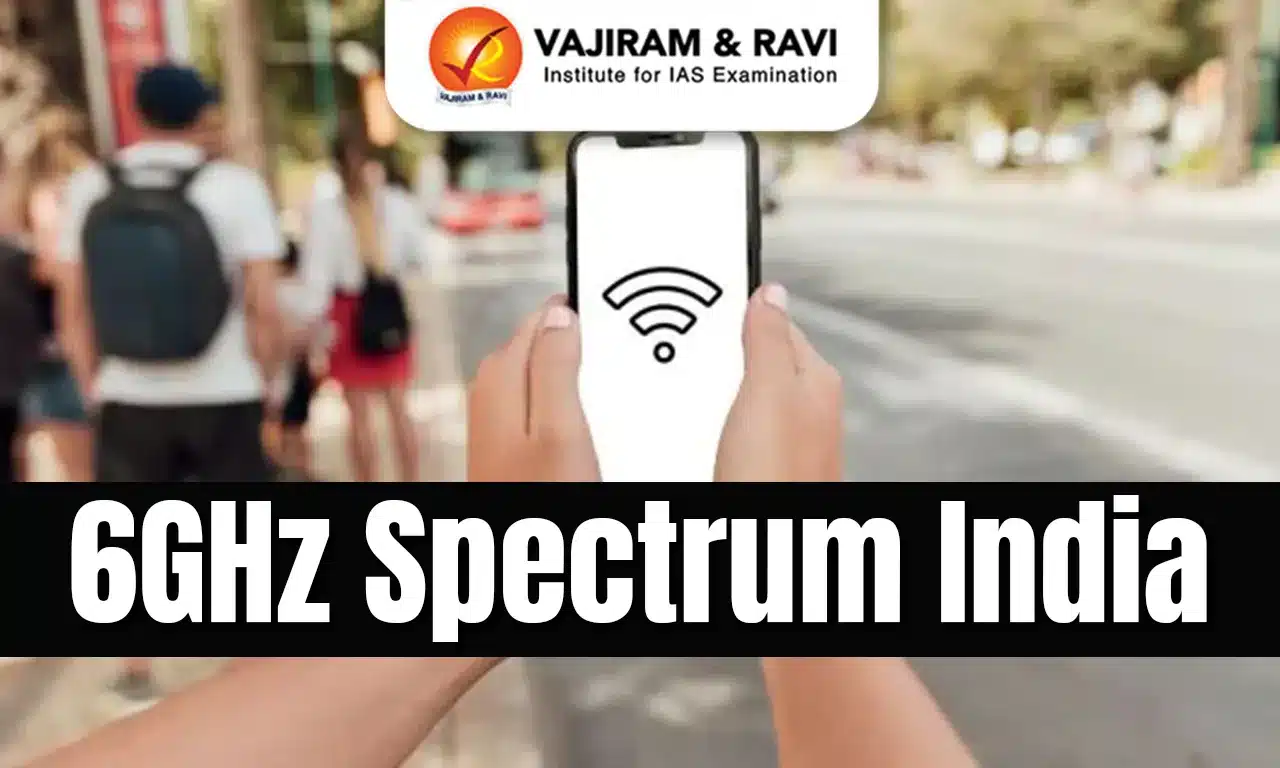6GHz Spectrum India Latest News
- The Indian government has proposed licence-free use of a part of the 6GHz spectrum, enabling faster WiFi and better connectivity.
- This move benefits tech giants like Sony, Apple, and Meta by supporting high-speed performance for devices like PlayStation Pro and VR gear.
Wireless Connectivity
- Wireless devices exchange data via radio waves, which are defined by wavelength and frequency.
- Frequency impacts: Data capacity; Speed of transmission; Range.
Understanding the Frequency Bands: 2.4 GHz, 5 GHz, and 6 GHz
- These bands represent specific parts of the radio frequency (RF) spectrum allocated for unlicensed wireless use.
- 2.4 GHz: Longer range, slower speed, more interference
- 5 GHz: Faster speed, shorter range, more congestion
- 6 GHz: Fastest speed, least congestion, shorter range, exclusive to latest devices
The 6 GHz Spectrum: The New Frontier for Wi-Fi
- Offers 1200 MHz of spectrum—more than double that of 2.4 GHz and 5 GHz combined.
- Supports seven 160 MHz channels for high-speed data transmission.
- Accessible only via Wi-Fi 6E devices.
Use Cases of 6 GHz Band
- Ideal for real-time applications like gaming, 4K/8K streaming, video conferencing, and cloud computing
- Reduces network clutter by avoiding interference from older devices
- Enables multi-device homes with smooth performance
India Opens Part of 6GHz Spectrum for Licence-Free WiFi Use
- The Indian government has proposed making a portion of the 6GHz spectrum (5925–6425 MHz) licence-free, enabling faster WiFi.
Spectrum Dispute: Telcos vs Tech Giants
- Telecom companies (Reliance Jio, Bharti Airtel, Vodafone Idea) wanted the full 6GHz band reserved for licensed 5G/6G services.
- In contrast, tech companies advocated for de-licensing to boost WiFi performance.
India’s Middle Path
- Unlike the U.S., which has made the entire 1200 MHz of the 6GHz band unlicensed, India has chosen a balanced approach by opening only the lower 500 MHz (5925–6425 MHz) for unlicensed use.
ITU Guidelines Influence Decision
- The International Telecommunication Union (ITU) in December 2023 had allocated the upper band (6425–7125 MHz) for licensed mobile operations, which India has adhered to in its draft policy.
Impact
- This move is expected to improve WiFi speeds across homes and enterprises, benefiting tech ecosystems while preserving space for future mobile technologies.
India’s 6GHz WiFi Move – A Boost for Tech, But Not Without Concerns
- Licence-Free WiFi Access in 6GHz Band
- As per the proposal, no authorisation or frequency assignment will be needed for operating low-power indoor and very low-power outdoor wireless systems, such as WiFi networks, in the 5925–6425 MHz frequency band.
- A Boost for Next-Gen WiFi and IoT
- Tech companies believe the move will support the adoption of next-generation WiFi technologies like WiFi 6E and WiFi 7.
- These technologies offer significantly faster speeds and are crucial for the expansion of the Internet of Things (IoT).
- Sony May Reconsider PS5 Pro Launch in India
- Due to earlier regulatory uncertainty over the 6GHz band, Sony had excluded India from the PS5 Pro launch.
- With the new draft rules, the company may now include India in its launch plans.
- Industry Says Partial Spectrum Not Enough
- Despite welcoming the move, industry experts emphasized that just a fraction of the 6GHz band is insufficient to unlock the full potential of WiFi 6E and 7.
- The Forum urges the government to free up more of the band to fully support India’s digital infrastructure goals.
- The Bigger Picture
- While the draft policy marks a major step for tech firms and connectivity, stakeholders stress that broader de-licensing is necessary for long-term digital growth and innovation.
Global Approach to 6GHz Spectrum: A Mixed Landscape
- Full Delicensing: U.S. and Canada Lead
- In April 2020, the U.S. Federal Communications Commission (FCC) opened the entire 6GHz band (1200 MHz) for license-exempt uses.
- Canada has adopted a similar policy, fully supporting next-gen WiFi technologies.
- Partial Delicensing: Cautious Optimism
- Countries like Japan, Australia, and Singapore have only delicensed a portion of the 6GHz spectrum for WiFi use, aiming to strike a balance between telecom and unlicensed wireless applications.
- Revisions and Debates: Chile and Mexico
- Chile initially opted to open the full band for WiFi but later reversed its decision.
- Meanwhile, Mexico is currently evaluating the possibility of broader harmonisation of the 6GHz spectrum for unlicensed use.
- Conclusion: Diverse Regulatory Paths
- While the global trend supports expanding WiFi access through the 6GHz band, approaches vary significantly, reflecting different national priorities and technological strategies.
6GHz Spectrum India FAQs
Q1. What is the 6GHz spectrum?
Ans. It’s a high-frequency wireless band enabling faster, less congested WiFi connections with modern devices.
Q2. Why is 6GHz important for tech companies?
Ans. It supports WiFi 6E/7 devices like PlayStation Pro and VR gear with high-speed, low-latency performance.
Q3. Which band is now licence-free in India?
Ans. The 5925–6425 MHz portion of the 6GHz band is now proposed for unlicensed use.
Q4. How does 6GHz compare to 2.4GHz and 5GHz?
Ans. 6GHz offers faster speeds and more channels but with shorter range than lower bands.
Q5. What’s the global stance on 6GHz use?
Ans. The U.S. and Canada allow full delicensing; India follows a partial delicensing model..
Last updated on June, 2025
→ UPSC Notification 2025 was released on 22nd January 2025.
→ UPSC Prelims Result 2025 is out now for the CSE held on 25 May 2025.
→ UPSC Prelims Question Paper 2025 and Unofficial Prelims Answer Key 2025 are available now.
→ UPSC Calendar 2026 is released on 15th May, 2025.
→ The UPSC Vacancy 2025 were released 1129, out of which 979 were for UPSC CSE and remaining 150 are for UPSC IFoS.
→ UPSC Mains 2025 will be conducted on 22nd August 2025.
→ UPSC Prelims 2026 will be conducted on 24th May, 2026 & UPSC Mains 2026 will be conducted on 21st August 2026.
→ The UPSC Selection Process is of 3 stages-Prelims, Mains and Interview.
→ UPSC Result 2024 is released with latest UPSC Marksheet 2024. Check Now!
→ UPSC Toppers List 2024 is released now. Shakti Dubey is UPSC AIR 1 2024 Topper.
→ Also check Best IAS Coaching in Delhi
Tags: india opens 6ghz spectrum mains articles upsc current affairs upsc mains current affiars






















